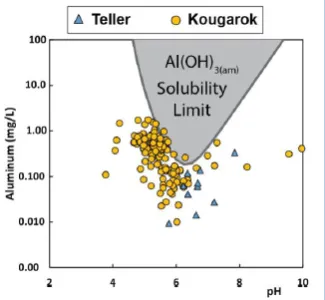Environmental controls on soil pore water concentrations of several solutes are inferred from spatial variability, co-located measurements, and thermodynamic geochemical models.
The spatial variability of soil pore water geochemistry in two permafrost underlain catchments was quantitatively evaluated, and the environmental controls on soil pore water concentrations of several ecologically important solutes were inferred. A combination of fiberglass wicks and MacroRhizons were used to sample the soil pore water geochemistry at 18 locations spanning two small permafrost underlain catchments (Teller and Kougarok) as part of the NGEE Arctic project. Mann–Whitney U-testing was conducted to deduce statistically significant differences in solute concentrations between Teller and Kougarok (inter-site variability) and between locations at each site (intra-site variability). Once statistically significant differences in solute concentrations were established, the concentrated co-located sampling approach utilized by NGEE Arctic was leveraged to determine the likely environmental controls on the observed spatial variability. The extent of permafrost, ground temperature, active layer depth, soil moisture content, snow depth, vegetation type, vegetation canopy height, dominant plant functional type, and hillslope position (hydrological transport) were all complied from these co-located studies. Hillslope position and mineral solubility were also considered using the geochemical modeling code PHREEQC. Vegetation-type influences on elemental cycles were only readily apparent for nitrogen, and although vegetation-induced changes to soil moisture content were discernable, they were far less significant than anticipated. Redox sensitivity was also less than was hypothesized, and most sampling locations seemed well buffered at iron redox conditions. Weathering, water/soil interactions, and hydrological transport were clear drivers of variability for Ca, Sr, and Mg, which all tended to accumulate in low-lying areas. Mineral solubility limitations were the primary controls on Al, Fe, Ba, and SiO2 concentrations via Al(OH)3(am), Fe(OH)3(am), barite, and chalcedony, respectively. To the best of our knowledge, this is the first study to combine field observations, non-parametric statistics, and thermodynamic modeling to understand the causes of soil pore water solute spatial variability in permafrost-impacted catchments.


